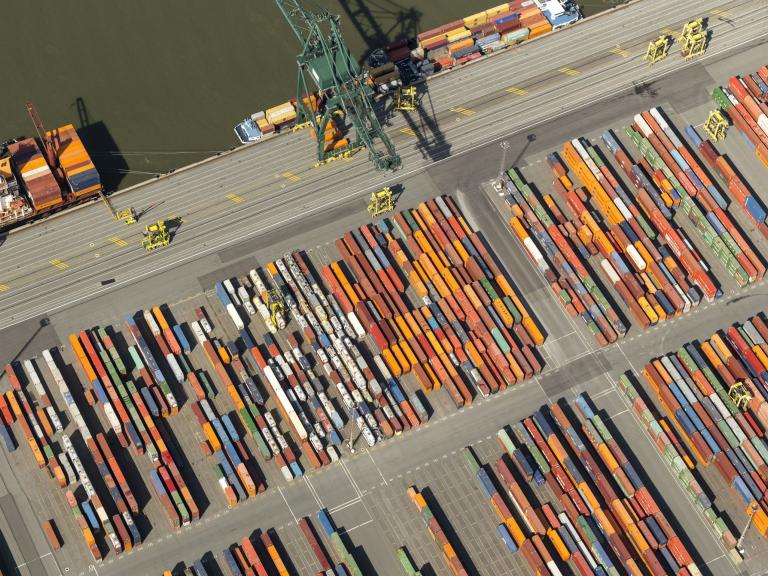-
Last updated on

A Belgian consular officer addresses arriving refugees. In the background, a stand with relief goods (© Ambabel Vienna).
On Thursday 24 February 2022, Russia invaded Ukraine. Although all the warning signs were there, the invasion still came as a surprise to many when it happened.
Afghanistan as an inspiration
Our Crisis Management Department had already been preparing for weeks in advance to assist our compatriots in Ukraine in the event of a Russian invasion. The implementation of Operation Red Kite in Afghanistan last summer served as an inspiration.
In close cooperation with our Embassy in Kiev, a detailed list of Belgians on the ground was drawn up. They were repeatedly urged to leave the country where possible. Many complied, although some chose to stay. At the time of the invasion, there were still about 250 Belgians in Ukraine.
Consular posts relocated
Meanwhile, the embassies bordering Ukraine, in particular Bucharest (Romania and Moldova), Warsaw (Poland and Belarus) and Vienna (Slovakia), prepared for the evacuation and reception of Belgian refugees. They undertook a reconnaissance mission along the border crossings, established useful contacts with the border guards and the crisis centres beforehand, and checked the potential transport and accommodation options.
As soon as the flow of refugees started after the Russian invasion, the crisis centre in Brussels was immediately opened. The Belgian embassies in Bucharest, Warsaw and Vienna set up consular posts near the border with Ukraine. The aim: to assist Belgians trying to escape, but also to monitor the flow of refugees and ensure contact with the border authorities.
The first consular team left for Košice from Vienna on 26 February. This second largest city in Slovakia, about 100 km from the Ukrainian border, was chosen as a base. This post would remain active for a month. Almost the entire embassy staff was called upon to man the post for 3 to 4 days at a time.

Hastily erected tents serve as temporary accommodation (© Ambabel Vienna).
From Košice to the Vyšné Nemecké border crossing
On the route from Košice to the Slovak-Ukrainian border crossing of Vyšné Nemecké, near the Ukrainian city of Uzhhorod, the emptiness and silence are striking. Small towns and sparse villages alternate in the foothills of the Carpathian Mountains. Here and there, cranes and herds of wild deer roam the vast fields where, in some places, the snow has not yet completely melted away. Only the long line of cars with foreign number plates parked along the road betrays the proximity of the border.
During these first days, mainly Ukrainians with family or friends elsewhere in Europe gradually crossed the border. Almost exclusively women and children, mostly on foot, with small travel bags and often with a pet. On the Ukrainian side, they spent about 12 hours having their papers checked. Afterwards, they were also checked and registered by the Slovakian Border Guard. When they see their loved ones, they don't express their emotions. The ordeal is not over yet.
Stands and tents
Several hundred people have gathered at the border; the atmosphere is serene. Some tents have been set up immediately past the border crossing by local aid associations; Slovakian citizens are constantly bringing relief supplies.
The Slovak authorities are managing the organisation, providing shelter tents and systematically improving the temporary infrastructure. After a few days, the relief supplies are housed in a proper (free) supermarket. A local bank and a telecom company have also opened a stand. A tent has been set up as a Greek Orthodox church. At the other smaller Slovakian border crossings, in Ubl'a and Vel'ké Slemence, there is a similar calmness and solid organisation.
Although clearly tired, the border police commander provides a briefing for the diplomats present on the situation and the profile and nationalities of the refugees. In addition to Belgium, Germany, France, Great Britain, Israel, the Czech Republic and the United States are also present with a consular team.

The relief goods delivered by B-FAST (© FPS Foreign Affairs).
B-FAST
After a few days, the statistics are up to date and a daily overview is distributed of the waiting times at the border and the number of refugees divided by nationality. Mostly Ukrainians, of course, but in the days following the invasion, many foreign students also fled the country.
For about two weeks after the invasion, the pressure on the Slovakian border remains high, with an average of 14,000 refugees per day. After that, the numbers drop gradually, returning to a normal level after about a month. Eventually, some 20 Belgians are also able to leave Ukraine via the Slovakian border.
In order to support Slovakia in its reception of Ukrainian refugees, Belgium, via B-FAST, is also transferring several convoys of relief supplies to the Slovakian authorities, including generators, mattresses, camp beds, blankets and sanitary material.
More on Services abroad

Belgium turns migration into a positive story
Provided the right approach is taken, migration can be a lever for sustainable development. The Belgian Development Cooperation ...

A strategy to make Belgium more resilient
Belgium now has a comprehensive ‘National Security Strategy’ for the first time. That should make our country more resilient aga...
